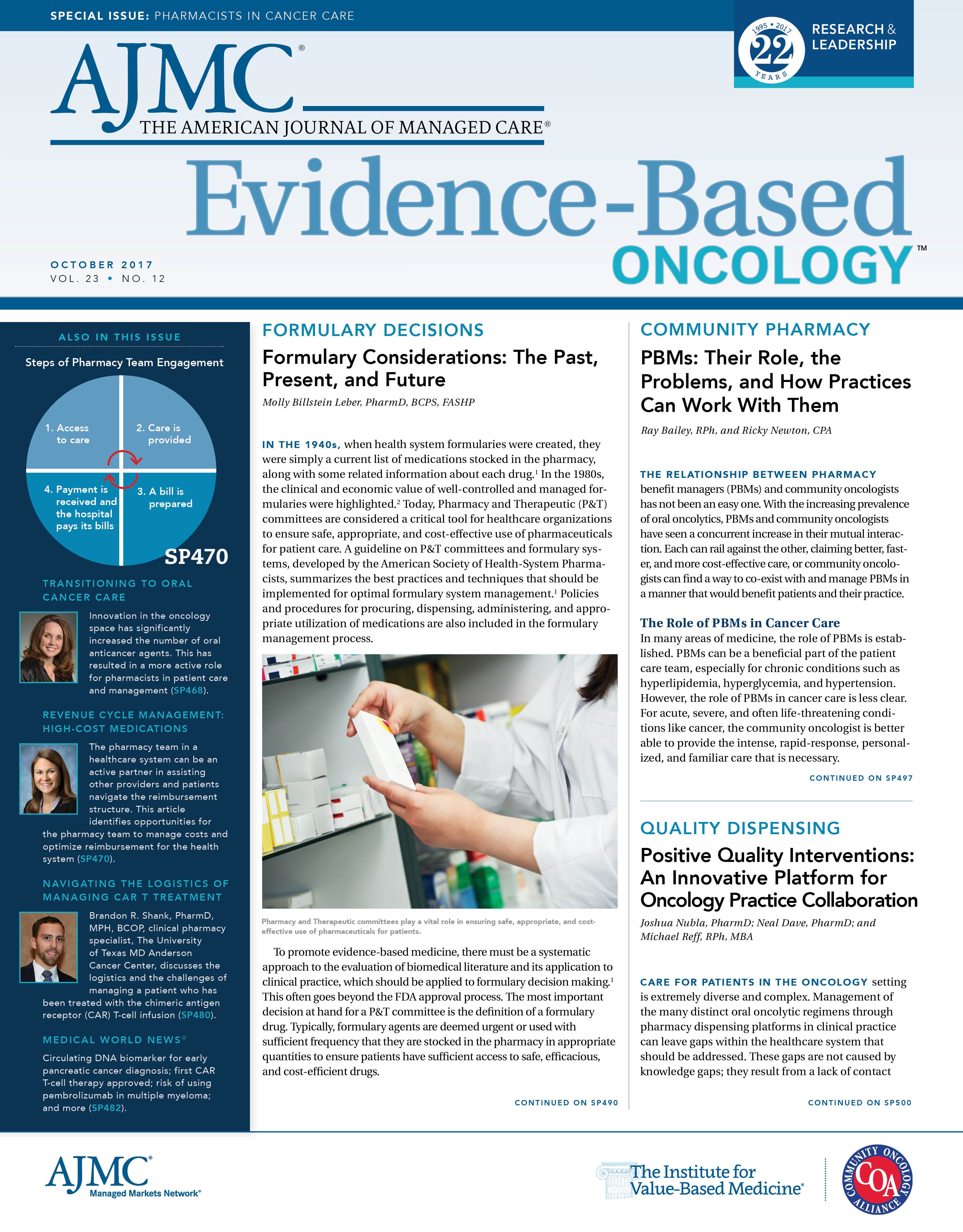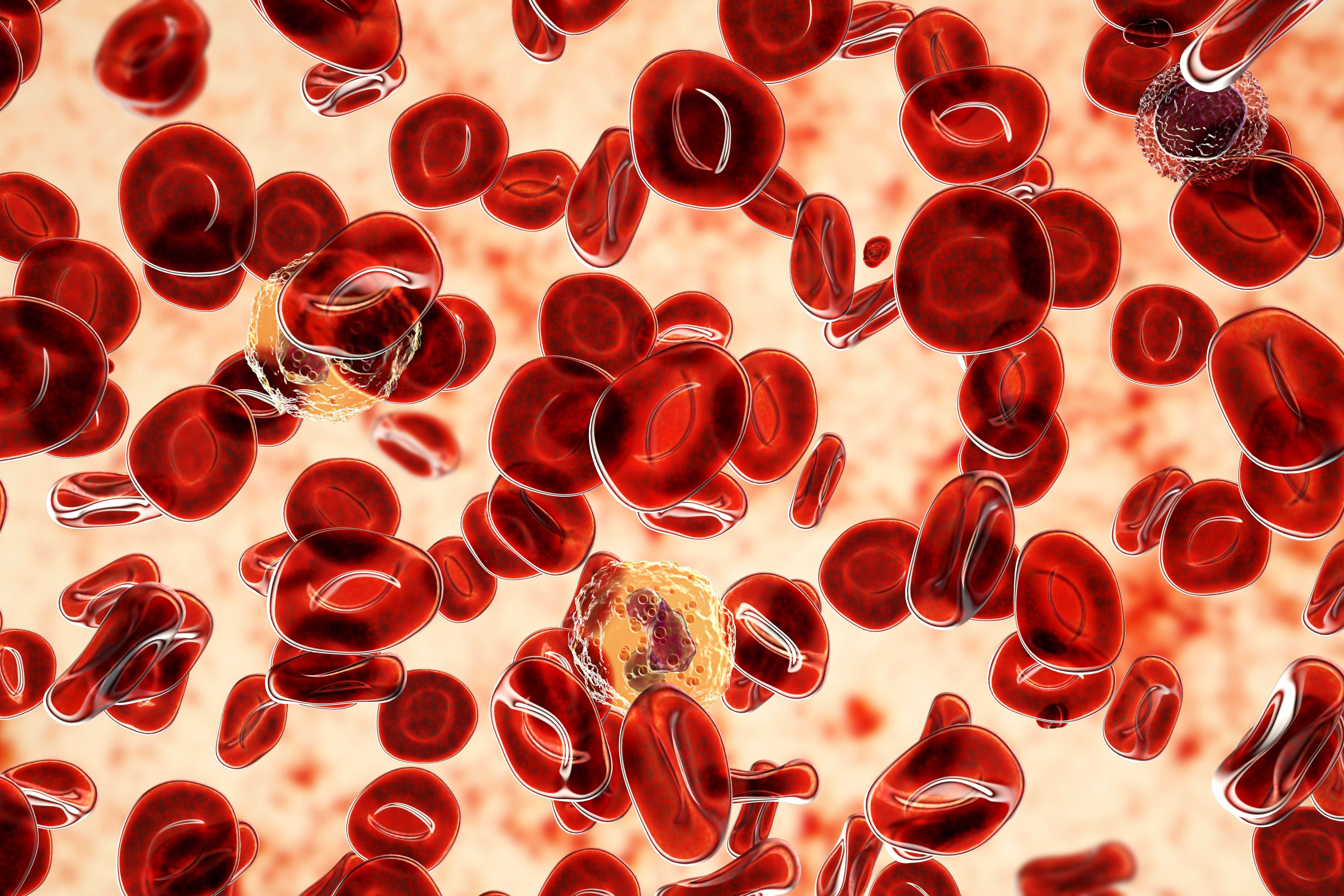Publication
Article
Evidence-Based Oncology
In Conversation With a Pharmacist: Management of CAR T-Cell Treatment
Author(s):
Evidence-Based OncologyTM sat down with Brandon R. Shank, PharmD, MPH, BCOP, clinical pharmacy specialist, Division of Pharmacy, The University of Texas MD Anderson Cancer Center, to understand a pharmacist's role in administering chimeric antigen receptor (CAR) T cells.
In August 2017,
the drug manufacturer Novartis became the first company to receive a green light from the FDA to market its chimeric antigen receptor T (CAR T)-cell gene therapy treatment. Tisagenlecleucel (Kymriah) has been approved for the treatment of B-cell precursor acute lymphoblastic leukemia (ALL) in a pediatric population (see sidebar).
Speaking with Evidence-Based Oncology™ (EBO™), Brandon R. Shank, PharmD, MPH, BCOP, clinical pharmacy specialist, Division of Pharmacy, The University of Texas MD Anderson Cancer Center, shared his experience with this treatment in his clinic. He explained the changes he anticipates may be needed for a safe, effective adoption of this new treatment modality in the oncology clinic.
EBO™:
Can you start by giving us a clinical understanding of the CAR T-cell therapy?
SHANK:
CAR T-cell therapy is a specific kind of therapy for patients in which T cells are trained to attack a specific antigen. One specific group so far is in ALL [acute lymphoblastic leukemia], and the specific product developed has an anti-CD19 on it. So, the patients undergo leukapheresis and then they are infused with cells that have been trained to attack the cancer, specifically leukemia—either acute or chronic. There are trials currently underway [that are testing] these cells in lymphoma and also in multiple myeloma with a different target. There are also trials evaluating different antigens on these CAR T cells.
This treatment has revolutionized cancer [care] because we have moved away from standard chemotherapy—although there is a place of CAR T cells getting a conditioning regimen with fludarabine or cyclophosphamide. [Overall, though,] we are moving away from the actual chemotherapy and instead, training the body’s immune system to fight the cancer.
:
EBO™What specific role do you play in delivering CAR T-cell infusion to patients?
SHANK
: My role is in the inpatient lymphoma service, specifically, with managing the logistics of the pharmacotherapy and toxicities of CAR T cells. On the formulary management side, hospitals now have to deal with adding 2 expensive medications—anti—IL-6 [interleukin-6] medications called siltuximab and tocilizumab—which are used to manage CRS [cytokine release syndrome]. So, from a formulary standpoint, institutions will need to develop order sets and make appropriate restrictions for the use of these agents.
Currently, most of my role on the service is to provide the supportive care and to manage the CRS and the CRES [CAR T-cell—related encephalopathy syndrome]. The pathophysiology of CRES overlaps with CRS, but this is specifically divided out to having encephalopathy. It’s a related but separate toxicity that’s been described recently by Neelapu, et al.
:
EBO™Can you describe the coordination among the various care providers when managing the toxicities associated with CAR T-cell infusion?
SHANK:
An interdisciplinary team [includes] the oncologist, the attending physician, the nurse practitioner, emergency [department] physicians, neurologists, ICU [intensive care unit] physicians, and other specialties. Many consult services, such as the neurology team, will assess the patients daily. As soon as I hear of an adverse effect, most commonly fever, we [begin] our sepsis work-up, starting intravenous antibiotics, and all this has to be done in a rapid manner as CRS can be a rapidly progressing syndrome.
We ensure that we avoid medications that would overlap or have overlapping toxicities, such as central nervous system suppressants, which could affect the differential assessment of the patients who develop CRS. We also avoid contraindicated medications, such as steroids. We have to monitor patients’ blood pressure, fluids, and electrolyte status, and also ensure that their home medications are continued or held if appropriate, as well as to start our standard prophylaxis.
Certain protocols may include Neupogen, which is fairly controversial; we have to work on the insurance coverage for this drug and then facilitate the transition to outpatient after they have completed treatment and are out of their window of CRS toxicities.
:
EBO™What is the duration for which patients are monitored for CRS toxicities?
SHANK:
We are more conservative in our assessment and management of these patients. When most of our patients are admitted following their conditioning chemotherapy, we monitor their ferritin and their C-reactive protein, which is an inflammatory marker used to help predict CRS. Depending on the [CAR T-cell] product that the patients have received, the time of T-cell expansion may vary following infusion. Depending on the product, we may keep the patients longer because we have to wait for the [T-cell] expansion to occur—as soon as there’s expansion, that’s when the CRS is most likely to occur. Other factors with possible association with CRS risk include the cell dose, extent of disease, or the patient’s age.
There’s also been new research out of the Fred Hutch Cancer Center [which concluded] that if a patient had a larger cell dose, high marrow tumor burden, or bulky disease, it increased the risk of CRS.
:
EBO™Were there specific work ow changes needed for more efficient team management of patients receiving CAR T-cell treatment?
SHANK:
I’d say that the acuity of when a CRS happens...it’s an emergency, which is different from some other chemotherapy toxicity. The patient decompensate faster. Another thing that is very di cult, and for which we have systems in place, is a mechanism to avoid administration of corticosteroids. It’s a common pre-med for blood products and platelets, but these [CAR T-infusion— treated] patients can’t receive any, and so e orts were made to educate staff to make sure that they don’t receive steroids.
As more patients undergo treatment with chimeric antigen receptor T cells, we will learn to better manage cytokine release syndrome.
Our standard admission orders needed to be altered for CAR T cells, because they include medications like zolpiderm or promethazine, which are medications that we try to avoid in this patient population.
These are some of the things we need to consider. I had one patient who was on a chronic, long-acting opioid medication, which gets tricky when you have to stop [the medication] abruptly if they have CRS, because they may develop withdrawal symptoms. So, there are many logistical barriers that are coming up now—we are learning how to manage the drugs in our arsenal when we are administering CAR T-cell infusion.
:
EBO™Going forward, what kind of infrastructure changes would you like to see in the way CAR T-cell treatment is currently delivered in the clinic to make it easier to manage these patients?
SHANK:
One of the needs would be the capacity of the drug companies to quickly amplify the modified T cells. The financial toxicity is a problem. One article estimated the cost at between $450,000 and $475,000 per treatment. The high cost will have a significant financial impact on our healthcare system. As more patients undergo treatment, we will learn to better manage CRS. We have made great strides in the last year or two managing these patients, but we can do better and focus on risk strati cation to determine which patients are at high risk.
If this proves to be the trajectory of cancer treatment, select therapies may be given in the outpatient setting or inpatient, with a potential 2- to 3-week stay. [It’s] similar to a stem cell transplant, but this will be done on a lymphoma service. There’s a lot that we will learn along the way, and there is a high likelihood of logistical challenges initially since a lot of patients are waiting to receive therapy.
With respect to formulary management, billing is another important question—will this treatment be billed as a medication or a blood product? What would be the role of the pharmacy? Those are some of the current unknowns with this treatment.
CAR T cells have had a profound impact and will have a tremendous impact on oncology care, for non-Hodkgin’s lymphoma and leukemia. As we learn more, and more trials are available, this will be a unique treatment option for patients who have failed chemotherapy.
AUTHOR INFORMATION
Brandon R. Shank, PharmD, MPH, BCOP, is a clinical pharmacy specialist, The University of Texas MD Anderson Cancer Center.






